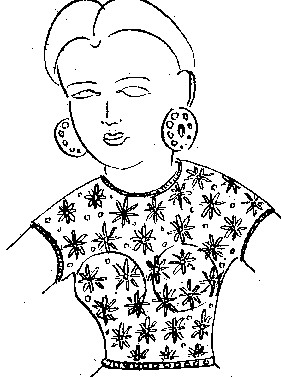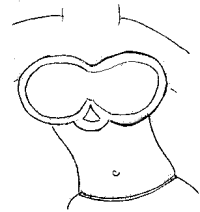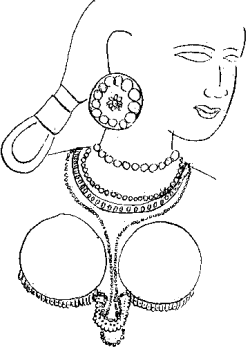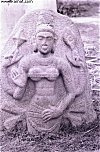.Ancient Brassieres
First Online: November 10, 1999
Page Last Updated: December 07, 2024
Turns out that Wonder-bra is not a fashion of the twentieth century alone! In this historically authentic pictures and references, Dr. (Mrs.) Jyotsna Kamat discusses the blouses and brassieres of ancient India.
Line drawings by K. L. Kamat.
-- Ed.
Although majority of female figures in ancient Indian sculptures are devoid of a blouse, there are several instances of ancient Indian women wearing brassieres. The first historical reference to brassieres in India is found during the rule of king Harshavardhana (1st century) in Kashmir. The half-sleeved tight bodice or kanchuka figures prominently in the literature of the period. From Basavapurana (1237 A.D.), we learn that kanchukas were worn by young girls as well. The Somanathacharita speaks of an aged harlot who used a special blouse to hold up her drooping breasts. Poet Harihara refers to wearing of tight white clothes (bigidudisi) before throwing of a shawl embroidered with gold, over the shoulders. Sewn brassieres and blouses were very much in vogue during the Vijayanagar empire and the cities brimmed with tailors (chippiga) who specialized in tight fitting of garments.

Tailored brassieres were popular during the Vijayanagar period, 14th century
The Leelavati Prabhanda mentions a kind of brassier prevalent in 10th century. While no pictures or detailed descriptions of it are found, a sculpture of the time has just a narrow strip to cover the nipples.

Medieval padded brassier
In a medieval sculpture from Karnataka, a brassier is sculpted around a deity (shown below) that appears to have been made up of thick cotton. Regularly sewn brassieres of cup-like shape are also found; some others appear to be propped up by ornaments.

Ornamental Brassier
Line drawing based on a temple sculpture.
The necklace is disguised as the support to hold up the cups
![]()
More Pictures:
Icon of a Devi (Goddess) |  |
 | Women in Undergarments |
Woman Doorkeeper from a Goan Temple |  |
 | Brassiere from a Medieval Sculpture |
Beauty Puts on a Brassiere (?) |  |
See Also:
- Saries for men! -- men's fashion in medieval Deccan
- Kulavis - Medieval headgear
- Other topics on Ancient India at Kamat's Potpourri
-
Kamat Saree Sapne --section on Indian Drapes
- Indian Attire Through the Centuries -- Pictorial history of clothing in India
- Indian Loin Cloth -- Article on the loin cloth of Kaupina and its role in understanding Indian culture.